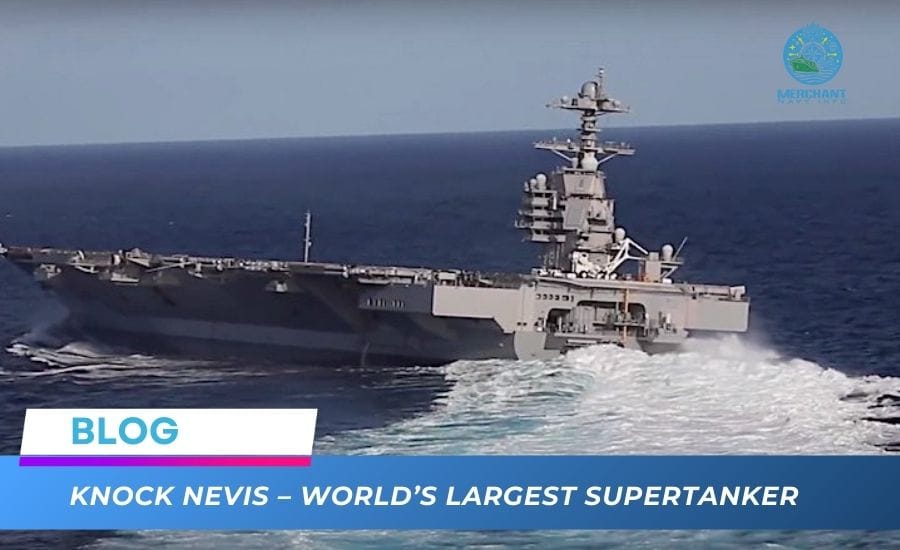
Knock Nevis – World’s Largest Supertanker
Few names inspire as much awe and fascination as Knock Nevis in sailing history. Known many times throughout its history – Seawise Giant, Happy Giant, Jahre Viking, and, finally, MV Mont – this Norwegian supertanker is not only the largest ship ever built but the largest ship ever built. Rather, it is a symbol of human ambition and resilience.
Measuring a staggering 458 meters (1,504 feet) from bow to stern and with a beam of 69 meters (226 feet), Knock Nevis rivals anything on the water, embodying unprecedented scale and grandeur. In 1979, a Greek shipowner commissioned Sumitomo Heavy Industries to build a tanker that would eventually become known as Knock Nevis. But her journey was anything but easy.
At the height of the Iran-Iraq War, known in naval circles as the “Tanker War”, the maritime giant, then known as the “Sea Giant”, fell victim to the chaos of the conflict while navigating the treacherous Strait of Hormuz. After being hit by a missile, it sank, its massive hull disappearing beneath the waves – a loss so devastating that it was declared a total loss, destined to be forgotten on the ocean floor.

However, like a phoenix rising from the ashes, the ship’s story did not end there. Shortly after the war, Norman International saw the wreck’s potential. In 1991, she undertook the arduous task of salvaging, repairing, and re-floating it. Renamed the Jahre Viking, she was returned to service and commanded a formidable presence on the world’s waterways. But her active naval days were numbered.
In her final years, the ship was repurposed as a fixed offshore platform, providing vital support to the oil industry. The once ocean-spanning supertanker stood still, a behemoth moored in place, a testament to its changing purpose.
By 2009, the ship had ended its famous voyage. After being sold to Amber Development Corporation and renamed MV Mont, she began her final voyage to scrapping in Alang, Gujarat, India. There, on the shores of one of the world’s largest shipbreaking yards, the Knock Nevis was deliberately dismantled piece by piece, her once-sturdy hull succumbing to the torches of the shipbreakers.
Knock Nevis may no longer dominate the seas, but her legacy as the largest ship ever built remains etched in history. It is more than steel and nails; she symbolizes an era, a testament to human ingenuity, and a reminder of the evolving nature of naval engineering.
How does Knock Nevis compare to modern megaships?
When it comes to giant ships at sea, the Knock Nevis is in a league of its own, but it’s not the only ship pushing the limits of engineering. The Prelude FLNG vessel is the world’s largest floating LNG platform, with a span of 488 meters (1,601 feet), slightly longer than the Knock Nevis vessel.
However, while the Prelude’s design prioritized cutting-edge technology and practicality over huge capacity, the Knock Nevis vessel was built to transport as much crude oil as possible.

In comparison, modern cruise ships such as Royal Caribbean’s Symphony of the Seas, despite their impressive length of 362 meters (1,188 feet), pale compared to the former supertankers. These floating cities prioritize passenger luxury and comfort, with amenities ranging from ice skating rinks to water parks.
Meanwhile, the world’s largest container ships, such as the 400-meter (1,312-foot) Ever Ace, are among the largest floating cargo ships, embodying a shift toward maximizing transport efficiency rather than sheer size. Each modern mega-ship serves a different purpose in today’s global economy. Still, the Knock Nevis remains a unique benchmark in the mega-ship space with its unparalleled size and oil-carrying capacity.
How does it compare to a U.S. Navy aircraft carrier?
Although the world’s largest warship, the flagship of the Ford-class aircraft carriers, the Gerald R. Ford, represents the pinnacle of naval power and technology, its size pales compared to the behemoth of the Knock Nevis. At 337 meters (1,106 feet) long and weighing around 100,000 tons, the Ford-class carriers were designed to act as mobile air bases, armed with advanced weaponry, and able to deploy more than 75 aircraft at any given moment.
Knock Nevis, in contrast, is a different kind of beast. At 458 meters (1,504 feet) long and weighing more than 564,000 tons when fully loaded, the ship was built not for speed or combat but to transport as much crude oil as possible across the world’s oceans.

Despite their size and nuclear power, they are relatively slow and weak, lacking the agility, defensive capabilities, and strategic versatility of the Ford-class carriers. Aircraft carriers symbolize military might and rapid response, while the Nork Nevis symbolizes industrial scale and global trade’s raw, unwavering force.
Both are engineering marvels in their own right, but where the Ford class demonstrates reach and intimidation, the Nork Nevis is a floating giant that embodies the massive scale of the global oil trade.
How does it compare to the heavyweight ship Pioneering Spirit?
Both Nork Nevis and Pioneering Spirit are giants of the sea, embodying very different scales in size and tonnage. In its heyday, the Nork Nevis was the largest ship ever built, measuring a staggering 458 meters (1,504 feet) in length and displacing more than 564,000 tons when fully loaded.
Designed for one purpose: to transport large quantities of crude oil, their sheer size is unmatched in the history of naval vessels. In comparison, the Pioneering Spirit, though an impressive feat of modern engineering, is 382 meters (1,253 feet) long, 124 meters (407 feet) wide, and has a gross tonnage of approximately 403,342 tons.

Although shorter than the Knock Nevis, the Pioneering Spirit’s unique double-hull design and massive 48,000-ton lifting capacity make it the world’s largest pipeline and construction vessel. Despite the difference in length and overall displacement, both ships were designed to dominate their respective fields: the Knock Nevis is a bulk transport giant, and the Pioneering Spirit is a marvel of heavy-lift construction.









